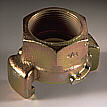
The blue version is the cheapest, but the thinnest and gives the least corrosion protection.
Yellow, black and olive are a little more expensive but thicker (better protection). Black and olive have also optical advantages (no reflection).
The conversion of the metal surface into a surface containing a mixture of chromium compounds is generally performed by dipping, but also by spraying or brushing.
Typical thickness is less than one micron (nanometer field).
Danish Name
Category
Materials
Zinc (steel electroplated parts)
Steel
Aluminium
Manganese
Chromium (coating)
Typical products
Competing processes
ReferencesArbeitsgemeinschaft - Galvanotechnik
Blasberg Oberflächentechnik GmbH
Galvanisk Kompagni
Holzapfel Metallveredelung GmbH
Price notes
Price date
Environmen- tal notes
Photo
Copyright
This page is part of Design inSite
Disclaimer